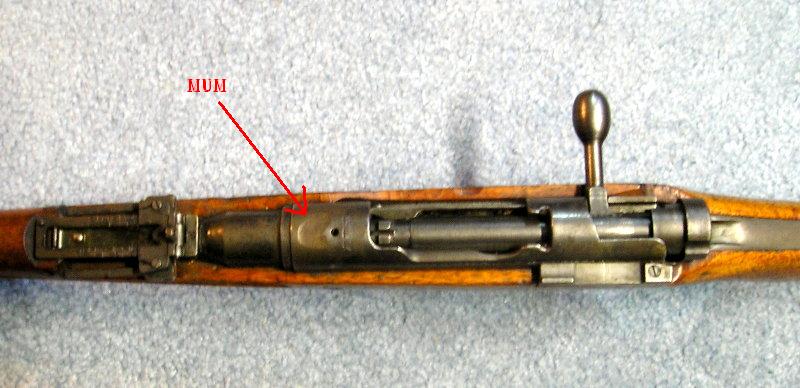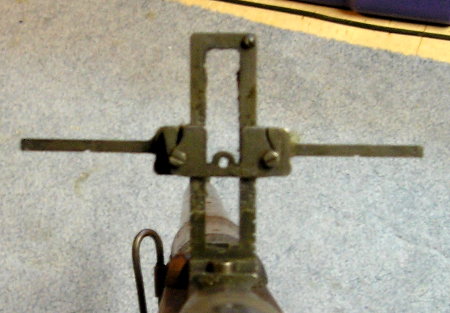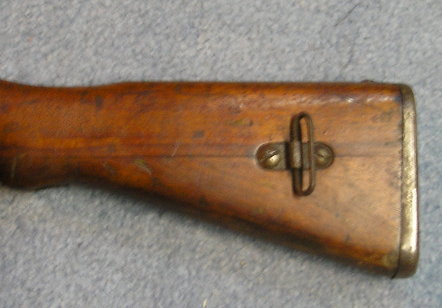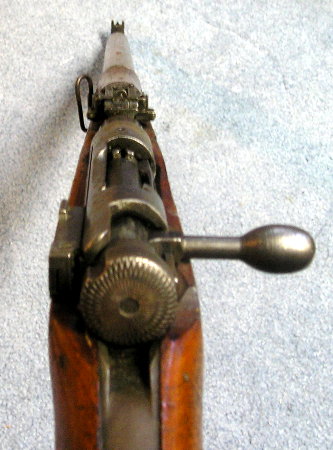
Type 99

The weapon pictured here is presently in the possession of the author, a gift from his wife's uncle, Alfred J. Buczkowski. He had obtained the weapon while stationed in Japan with the occupational forces in 1945.
The Arisaka rifles are named for Colonel Nariakira Arisaka, who headed a commission during the 1890s which was charged with developing a new rifle to replace the earlier models such as the Murata. During the reign of Hirohito, rifles were designated by the last one or two digits of the adoption year according to the standard Japanese calendar. Thus, the Type 99 rifle was adopted in Japanese calendar year 2599 (1939).
![]()
![]()
![]() symbols on the receiver indicate that this is a Type 99, a 7.7mm rifle.
symbols on the receiver indicate that this is a Type 99, a 7.7mm rifle.
 |
The Chrysanthemum has been ground completely off on this example. There are two stories as to why this was done. One is that the Japanese did it as a face-saving gesture to avoid surrender of property that belonged to the Emperor. The second is that General MacArthur ordered it done to remove the symbol and suppress nationalistic pride. Examples with the Chrysanthemum intact indicate that the weapon was captured rather than surrendered. |

![]() These symbols indicate
this rifle was made by Kogyo manufacturing company for the Toyo arsenal. Kogyo
made over 557,000 rifles from 1939 to 1945.
These symbols indicate
this rifle was made by Kogyo manufacturing company for the Toyo arsenal. Kogyo
made over 557,000 rifles from 1939 to 1945.
![]() symbol indicates it is a Series
32 manufacturing run, probably around 1942-43 as this was the third of five
complete series made by this Kogyo. They also made another 57,000 of a sixth
series before production stopped in 1945.
symbol indicates it is a Series
32 manufacturing run, probably around 1942-43 as this was the third of five
complete series made by this Kogyo. They also made another 57,000 of a sixth
series before production stopped in 1945.
 |
The serial number 51,844 is from a series of 0 to 99,999. The serial number on the bolt matches the one on the receiver. (They were often switched as the parts were identical.) The dust cover is not present. Because it often rattled when carried and operated, many soldiers got rid of the cover soon after being issued the weapon. The barrel is chrome plated, a good practice for the high humidity of the Pacific. The rear sight is the fold-down style with adjustable slide, including the anti-aircraft fold down arms. |
| The stock of the Type 99s consisted of two pieces of wood which were milled separately and then glued together. One of the common finishes was discovered to be allergenic, causing many of the soldiers and sailors that sanded the stocks to refinish them to experience itching and rashes. Caution, as well as long sleeves and gloves, should be used when refinishing. |
 |
 |
Some Type 99 rifles included a wire tripod that folded up against the stock. This example does not have the fittings associated with the tripod. Type 99 rifles made toward the end of the war were of a reduced quality compared to the earlier models. They had fixed rear sights, the barrels were not chromed and there was no metal butt plate on the weapon. The metal was obtained from numerous sources and was inferior and sometimes not safe for the user. While there were many sources for information used in creating this information, Brian Brown's web site Markings on Japanese Arisaka Rifles and Bayonets of World War II contains the bulk of the information on markings and he lists a number of detail references that he used. |
This page was created by Mark Swarthout.
The last update to the page was on February10, 2010.
Send me some mail!